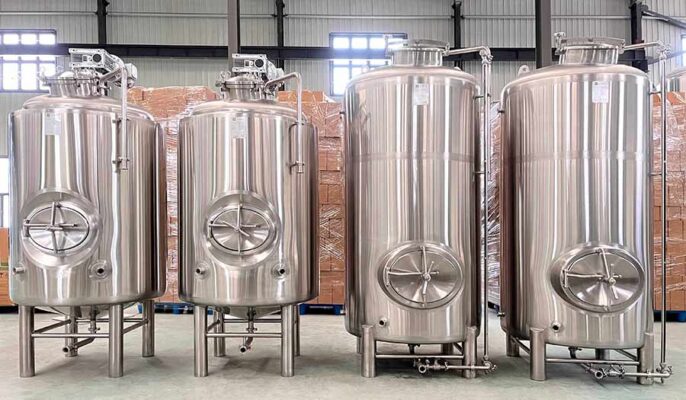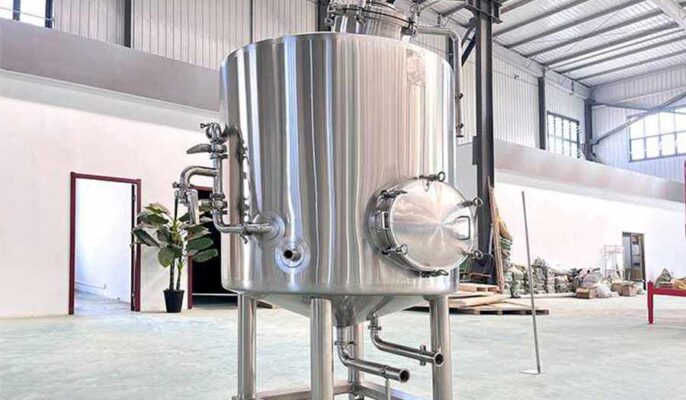In recent years, kombucha has become a popular fermented beverage. The use of stainless steel equipment in the brewing process brings multiple benefits, and stainless steel equipment has become a popular choice for enthusiasts and commercial brewers alike. If you’re a beer brewing enthusiast or looking to venture into the kombucha sector, then you can learn about the benefits of stainless steel equipment for brewing kombucha with Micet Group.
Kombucha in a nutshell
Kombucha is a fermented beverage of ancient origin known for its health benefits. It is usually made by fermenting tea leaves, sugar, and SCOBY (Symbiotic Culture of Bacteria and Yeast), a group of organisms that look like thick fungal discs and consist of a variety of beneficial bacteria and yeast.
The fermentation process of kombucha allows the sugars in the tea to be converted by these microorganisms into lactic acid, acetic acid, and a small amount of alcohol. These fermentation products give kombucha its characteristic sour flavor and subtle effervescence while enriching its nutritional value.
Kampot tea is believed to contribute to digestive health, enhance immune system function, and may have some inhibitory effect on inflammation in the body. Although the exact health benefits are still being researched by the scientific community, it is becoming increasingly popular and preferred by health-conscious individuals as a natural, low-sugar, and low-calorie beverage.

Types of materials for コンブチャ装置
The material of brewing equipment for kombucha can be chosen from different types according to the needs and preferences, mainly considering its hygiene, corrosion resistance, temperature control ability, and impact on the quality of the drink.
プラスチック
Plastic is cheap and easy to manufacture, but care should be taken when using it. Due to the acidic nature of kombucha, only certain types of plastic are suitable for brewing kombucha. Plastic is usually cheaper than glass, but you need to make sure it won’t scratch or break, and sometimes plastic is not as strong as glass. Plastic is lightweight, unbreakable, and easy to clean. However, long-term use may be affected by temperature and some plastic materials may produce an odor. Therefore, in kombucha equipment, plastic is usually used in parts that are not in direct contact with the tea beverage or low-temperature areas.
Ceramic
Ceramic materials are also aesthetically pleasing, easy to clean, resistant to discoloration, and durable. Although ceramic is rarely used directly in kombucha equipment, it may be used in certain accessories or decorative parts. Tubular plastics are relatively cheap and lightweight, but they are generally not recommended for long-term kombucha brewing due to their potential chemical reaction to food. However, food-grade high-density polyethylene (HDPE) plastic may be a relatively safe and economical option.
ガラス
Glass containers are a common choice for the kombucha brewing process. Not only will it not react with the acidity of the beer, but it is also less likely to scratch or contain chemicals such as BPA. You’ll need at least 1.5 liters, but 2 liters or larger is better. For continuous brewing systems, a larger glass kettle with a tap is required. Glass is transparent and allows you to observe the fermentation process of kombucha, making it easy to monitor and make adjustments. Glass containers are suitable for home or small-scale makers, especially where the appearance and transparency of the product is of high importance.
Wooden material
Wood containers are sometimes used in traditional kombucha brewing, but they are not a common choice because they are difficult to clean and absorb liquids easily, making them a breeding ground for bacteria. Some traditional or region-specific makers may choose wooden barrels for brewing kombucha, but special attention needs to be paid to cleaning and sanitizing.
ステンレス鋼
Stainless steel is the material used in the fermentation process for beer, wine, kombucha, and spirits. Stainless steel is the material of choice for many commercial breweries and professional home breweries because it is durable, scratch- and stain-resistant, and offers excellent temperature control. However, stainless steel fermenters tend to be more expensive than other options.
Key Components of a Campe Tea Brewery
The hot end of a kombucha brewery (also known as a “distillery”) is used to heat the water to which the sugar-infused black or green tea is added to provide SCOBY with the nutrients needed to make kombucha. The sweet tea from the kombucha brewery is cooled to just above room temperature and then transferred to the kombucha fermentation tanks.
- Brewing and blending vessel
- 発酵容器
- ろ過システム
- 炭酸化システム
- 瓶詰め・缶詰ライン
- Sterilization systems
- 温度制御システム
Benefits of Stainless Steel Equipment for Brewing Kombucha
- Durability: Stainless steel is known for its durability. Stainless steel consists of chromium, an element that is resistant to corrosion and stains. Unlike other materials that degrade over time, stainless steel tanks are resistant to rust, corrosion, and rusting. This means that with proper maintenance, stainless steel tanks can serve breweries for decades.
- Corrosion resistance: the brewing process of kombucha requires contact with acidic liquids (such as tea and vinegar), and stainless steel can effectively resist the erosion and corrosion of these acidic substances, to ensure the long-term stability and durability of the brewing equipment. In contrast, other materials may corrode and oxidize after a long period, which is not conducive to the production and quality control of kapu tea.
- Hygiene and cleanliness: The non-porous nature of stainless steel allows it to resist the growth of bacteria and microorganisms. This is vital for brewing, as contamination can ruin an entire batch of kangpu tea. Stainless steel surfaces are easy to clean and sanitize, effectively avoiding cross-contamination and the growth of undesirable microorganisms, ensuring the quality and food safety standards of the Camphor Tea.
- Brewing Consistency: Consistency is the hallmark of a successful brewer. Stainless steel tanks with temperature control and air tightness provide the environment to brew each batch under the same conditions, ensuring consistency in the flavor and quality of Kombucha.
- Temperature Control: Stainless steel has good thermal conductivity, which helps maintain a stable temperature during the brewing process. Temperature control during the fermentation process of Camphor Tea is crucial for the formation of flavor and nutrients, and stainless steel equipment can effectively help yeast and bacteria ferment under the right temperature conditions to promote the flavor and nutritional value of Camphor Tea.
- Environmental protection and sustainability: Stainless steel is a recyclable material that can be recycled and reused after many uses, reducing the burden on the environment. The use of stainless steel equipment for brewing Camphor tea is not only conducive to food safety and quality control but also in line with the concept of sustainable development, causing less impact on the environment.

How to choose the right コンブチャ装置?
When choosing kombucha brewing equipment, it is important to select a container that is food-safe, easy to clean, and large enough to hold the amount of brew.
- Size: Choose a brewing container that can hold the desired batch of kombucha. Consider how much kombucha you will be brewing at one time and then choose your container. It is important to have enough space for the SCOBY and liquid to ferment.
- Materlal: Choose a brewing container made of glass or ceramic. These materials are ideal because they are non-reactive and will not interact with the acidity of the kombucha. Avoid containers made of plastic or metal, as they can leach chemicals into the beer, affecting the flavor and quality of the kombucha.
- Quality: Invest in high-quality equipment that meets food safety standards and is designed for brewing kombucha. Look for containers and lids that are durable and can withstand the fermentation process. Quality equipment lasts longer and provides a better brewing experience.
- Convenience: Consider how easy it is to clean, assemble, and use the equipment. Brewing kombucha requires regular maintenance and cleaning, so choose equipment that is easy to clean and sanitize. Look for lids that fit and are easy to remove and replace. Easy operation of the equipment will make the brewing process more enjoyable.
よくある質問
Q: Is it safe to brew kombucha in a stainless steel kombucha fermenter?
A: Yes, stainless steel コンブチャ発酵器 are safe kombucha brewing equipment. They do not react and do not leach any harmful substances into the brew.
Q: Can I use a stainless steel fermenter to make other fermented beverages?
A: Absolutely! Stainless steel fermenters are versatile and can be used to ferment a wide range of beverages, including beer, wine, and cider.
Q: How do I clean my stainless steel kombucha fermenter?
A: Cleaning your stainless steel kombucha fermenter is easy. Use warm water and a mild detergent to remove any residue, then rinse thoroughly. For stubborn stains, you can use a mixture of water and vinegar or a specialized stainless steel cleaner.
Q: Do stainless steel fermenters require special maintenance?
A: Not particularly. Stainless steel fermenters are very low maintenance. Simply make sure it is thoroughly cleaned and dried after each use to prevent any potential contamination.




